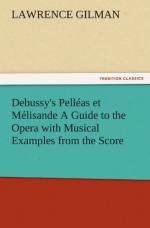had been off Wagner’s desk for only seven years,
that Richard Strauss was putting forth such tentative
things as his Don Juan and Tod und Verklaerung,
that the “revolutionary” Max Reger was
a boy of sixteen, and that Debussy himself was not
yet thirty, one is in a position forcibly to realize
the early growth and the genuineness of his independence.
Adolphe Jullien, the veteran French critic, discerns
in his earlier writing the influence of such Russians
as Borodine, Rimsky-Korsakoff, and Mussorgsky—a
discovery which one finds some difficulty in crediting.
Later, Debussy was undoubtedly affected, in a slight
degree, by Cesar Franck; and there were moments—happily
infrequent—during what one may call his
middle period, when a whiff of the perfumed sentiment
of Massenet blew disturbingly across his usually sincere
and poetic pages. But for traces of Liszt, or
Berlioz, or Brahms, one will search fruitlessly.
That he does not, to-day, touch hands at any point
with his brother musicians of the elder school in
France—with such, for example, as the excellent
and brilliant and superbly unimaginative Saint-Saens—goes
almost without saying. With Vincent d’Indy,
a musician of wholly antipodal qualities, he disputes
the place of honor among the elect of the “younger”
school (whose members are not so young as they are
painted); and he is the worshiped idol of still younger
Frenchmen who envy, depreciate, and industriously
imitate his fascinating and dangerously luring art.
He has traveled far on the path of his particular
destiny; not since Wagner has any modern music-maker
perfected a style so saturated with personality—there
are far fewer derivations in his art than in the art
of Strauss, through whose scores pace the ghosts of
certain of the greater dead. All that Wagner could
teach him of the potency of dissonance, of structural
freedom and elasticity, of harmonic daring, Debussy
eagerly learned and applied, as a foundation, to his
own intricately reasoned though spontaneous art; yet
Wagner would have gasped alike at the novelty and the
exquisite art of Pelleas et Melisande, of the
Nocturnes, even of the comparatively early
Prelude a l’Apres-midi d’un Faune;
for this is music of a kind which may, indeed, have
been dreamed of, but which certainly had never found
its way upon paper, before Debussy quietly recorded
it in his scores.
What is the secret principle of his method?—if one can call that a “method” which is, in effect, nothing if not airily unmethodical, and that principle “secret” which is neither recondite nor perplexing. It is simply that Debussy, instead of depending upon the strictly limited major and minor modes of the modern scale system, employs almost continuously, as the structural basis of his music, the mediaeval church modes, with their far greater latitude, freedom, and variety. It is, to say the least, a novel procedure. Other modern composers before Debussy had, of course, utilized




